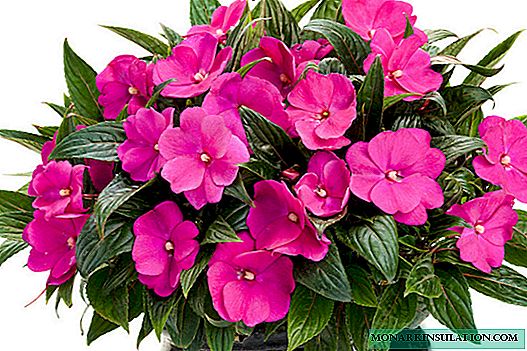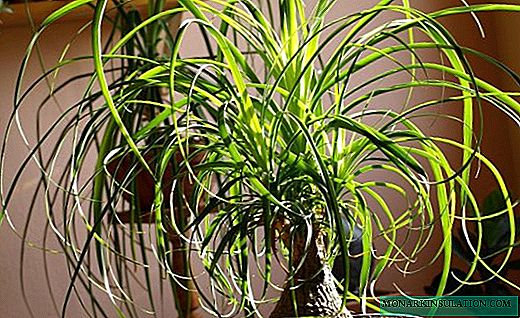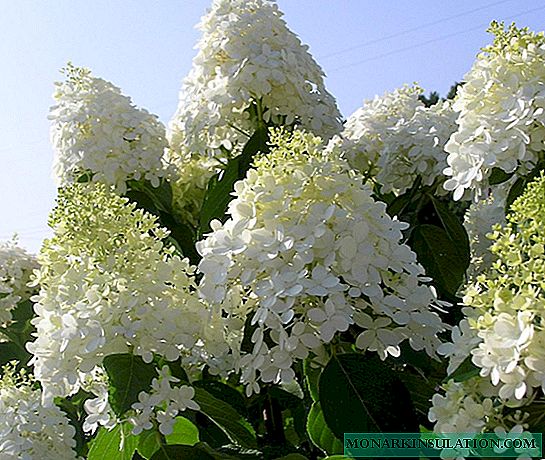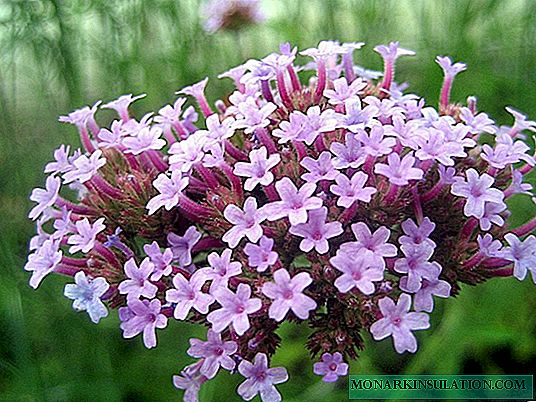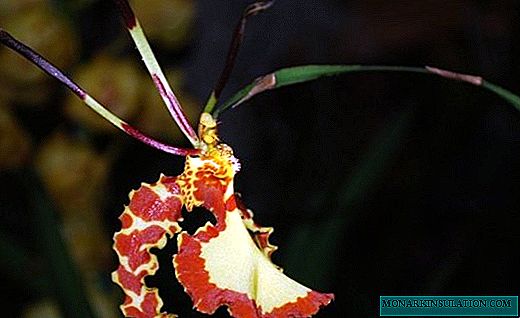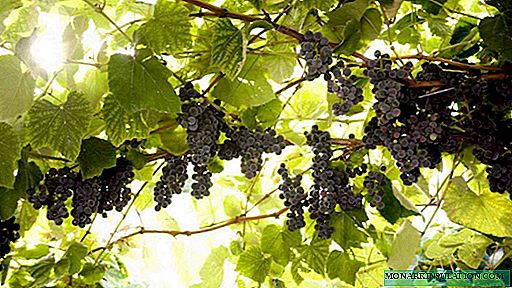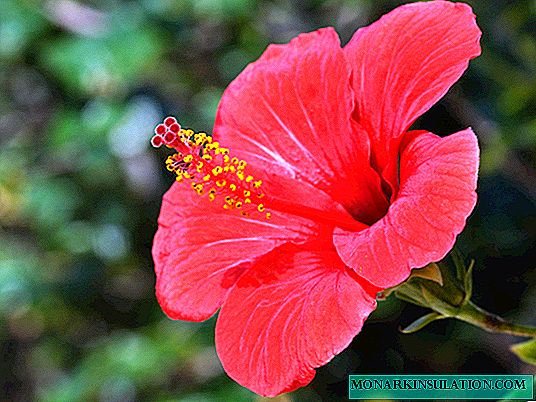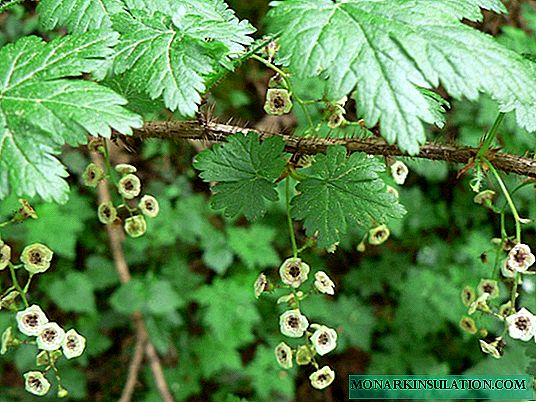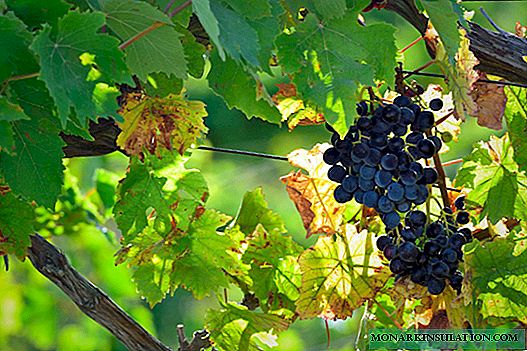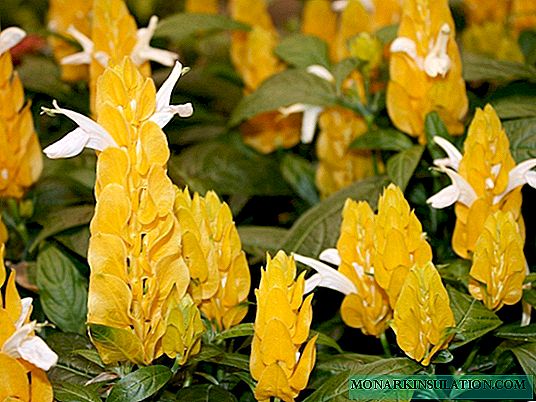
Pachistachis has been grown at home since the 19th century. The plant pleases the eye with decorative juicy leaves, unusual spike-shaped inflorescences, a long flowering period. Unfortunately, this luxurious flower is rarely seen on our windowsills. For some reason, it is believed that pachistachis is finicky, moody, and requires complex care. But it’s not so, even a novice grower can grow a plant.
Description

Blooming pachistachis yellow
Pachistachis is a tropical flower that grows naturally in eastern India, central and southern America. It grows in the form of a bush, the height of an adult plant is 2 m, oval leaves of saturated green color are directed down. It is valued for its original bright yellow or red bracts in the form of a ten-centimeter spikelet, against their background small white flowers are almost invisible. The flowering period is from early spring to mid-autumn, the flowers themselves fall quickly, but the bracts do not lose their decorative effect for a long time. The plant feels quite comfortable in room conditions, prefers high humidity.
Varieties of Pachistachis
There are 12 plant varieties, of which only two varieties are domesticated - yellow (Pachystachys Lutea) and a rarer red pachistachis (Pachystachys coccinea). Yellow pachistachis is a shrub 1-1.2 m high, with upright shoots, the lower part of which grows wooden over time. The shape of the leaves is oval with narrowed tips, size - 5 cm wide and 15 in length. The spike-shaped inflorescences are covered with bright yellow bracts, from which small white flowers appear.
Pachistachis red differs from its relative in the size of the bush and the color of the inflorescences. In this species, the bracts are dark green in color; rather large red flowers appear on them. Bushes can grow up to 2 m, apparently, due to its impressive size, the plant is rarely found in home flower collections.
Photo Gallery: Varieties of Pachistachis

- Pachsitachis red flowers
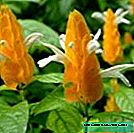
- Yellow pachistachis flowers

- yellow pachistachis in vivo
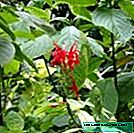
- Red pachistachis in vivo
(Pachystachys coccinea)
Table: Features of care depending on the season Factor Spring, summer Autumn, winter
| Factors | Spring Summer | Autumn winter |
| Lighting | Diffused light without bright sunlight. Optimal - north or west windows. If the pot is located on the south side, it should be shaded. | It is necessary to provide good lighting. With a lack of light, illuminate with a phytolamp. |
| Temperature | 20-25 ° C | 16-18 ° C |
| Humidity | Loves humid air. Hot weather the plant needs to be sprayed Reserved water. For promotion humidity container with flower set on a tray filled with pebbles and water. | Spray with water several times a week. |
Such conditions are suitable for growing Descriptions, read about it: //diz-cafe.com/rastenija/pavlinij-cvetok-ili-episciya-kak-obespechit-ej-v-domashnix-usloviyax-dostojnyj-uxod.html
Landing and transplanting: drainage, soil and pot selection
Young plants need replanting every spring. Adult flowers change the soil once every 2-3 years. The most suitable time for the transfer of pachistachis to another pot is early to mid-March. Before transplanting, the plant is pruned. The flower is planted in nutrient soil enriched with humus. Ready-made soils for flowering plants can be used. Pachistachis does not tolerate stagnation of water, so the lower part of the pot is necessarily filled with a layer of drainage (1-2 cm): pebbles, expanded clay, clay shards.
The composition of the soil for self-preparation:
- Peat - 1 part.
- Sod land - 2 parts.
- Sand and humus - 1 part each.
- Sheet earth - 1 part.
Young plants are planted in medium-sized pots with a volume of 1-1.5 liters. Capacities should not be too high, it’s good if you can find dishes with the same height and diameter. Each next transplant is made into a pot 1-1.5 cm wider than the previous one. Adult plants are planted in containers with a volume of 2.5 liters, the proportions of height and diameter are preserved.
Home Care
The plant is not capricious, however, if the rules of care are not followed, it loses its presentation, ugly stretches out, discards leaves and ceases to bloom. Watering and top dressing, the choice of fertilizer depending on the season. Pachistachis is sensitive to both overflow and drying out. In the summer, the flower needs frequent watering, as soon as the topsoil dries. In no case should it be allowed to completely dry up an earthen coma.
In winter, watering intensity is reduced to 3 times a week. You can use only soft water without admixture of mineral salts. Tap water should be left standing for several days before use. During the period of active growth, starting from the first days of April and ending with September, pachistachis is fed with complex mineral fertilizers and organics. The procedure is performed every 14 days. You can use liquid complex fertilizers for flowering plants, such as Agricola, Fasco, Living Force.
Spring pruning

Trimming of pachistachis at a distance of 10-15 cm from the ground
In nature, the pachistachis bush grows to 1.2 (yellow) and up to 2 m (red). At home, uncontrolled growth will lead to a loss of decorativeness of the plant - the lower part will be ugly exposed, the size of the internodes will increase, part of the foliage will be lost. To form a compact and harmonious crown, pachistachis need to be cut or pinched every spring. The first pruning is carried out at a distance of 10-15 cm from the ground. In the future, you need to pinch all the branches over the second pair of leaves. Each spring, the tops of the flower are cut off to stimulate flowering. If you adhere to these rules, in a few years you will become the owner of a plant with a beautiful crown.

Scheme for further trimming of pachistachis
Flowering period
One of the main advantages of a perennial is its beautiful, candle-like flowers. The main task of the owner is to provide all conditions for long and lush flowering. With proper care, flowering lasts from early March to mid-autumn.
Also, exotic flowering is valued medinilla. You can find out how to provide her with decent care at home from the material: //diz-cafe.com/rastenija/medinilla-kak-obespechit-ej-dostojnyj-uxod-v-domashnix-usloviyax.html
What factors affect the appearance of peduncles:
- Correct temperature conditions, necessary humidity, plentiful watering.
- A sufficient level of lighting, with a lack of light, the pachistachis will not be able to form flower buds.
- Fertilizing with complex fertilizers during the growth period. Mandatory spring pruning. Flowers are formed only on new shoots.
After the plant fades and the bracts begin to dry, they must be cut with at least one pair of leaves. This stimulates the further growth of pachistachis and the laying of new buds.
Rest period
In late October, after flowering ends, a dormant period begins. Pachistachis growth slows down. Even moisture during its rest, the plant consumes in much smaller quantities. But in no case should the land be dried out, the flower will quickly respond to insufficient watering - large leaves will begin to wrap the edges down, in an attempt to preserve precious water. Care for pachistachis during rest:
Watering every other day.
- Stop fertilizing.
- Do not trim.
- Do not transfer into the shade, leave the pot on the east or west windowsill.
Table: How do care errors appear (curl, fall leaves, etc.) and what to do to correct the situation
| Signs | Cause | Treatment | Prevention |
| Leaves twist become lethargic | Low humidity or lack of watering. | Water the plant more often. | Set the pot on the pallet with wet expanded clay. |
| Mass drop of leaves | Too cold or too dry. | Move the plant to a warmer place. Water the flower. | Avoid hypothermia or drying of the earth. |
| The bush is very stretched, takes an ugly shape | There is not enough light or the flower is cropped incorrectly. | Move to a lighter place, trim. | Keep pachistachis on the east or west window, cut the shoots every spring. |
Photo Gallery: Care Mistakes
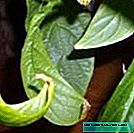
- Pachistachis with flaccid and twisted leaves
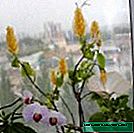
- Pachistachis with discarded leaves
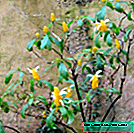
- Pachistachis with overly elongated shoots
Diseases and pests, their signs, preventive measures and treatment
With proper care, pachistachis is practically not susceptible to disease, but it can suffer from numerous insect pests. The plant most often becomes infected from nearby sick flowers or infected bouquets brought into the house. Some diseases, such as powdery mildew, are carried with air currents.
Table: pests and diseases, signs, treatment and prevention
| Disease or pest | Signs | How to fight | Prevention |
| Aphid | White appears on the plant plaque and traces of sweet syrup. Further leaves are covered with soot fungus (black spraying). Shoots covered with insects seem fluffy. | In the first stage of infection pachistachis every day need rinse with warm running water. In advanced cases the plant is treated with interval of 6-8 days Fitoverm (2 ml per liter of water) or Intavir (1 tablet per 10 liters of water). | Inspect the flowers regularly for infection. Systematically spray with water, as the aphid tries not to settle on wet leaves. Put everything only acquired plants in quarantine. |
| Shield | Sticky plants liquid on the shoots and the inside of the leaves convex appear brown oval spots solid form to the touch. | Wipe the plant daily a sponge moistened in a solution of brown household soap (1: 3) or process all affected flowers Actelikom (2 g per liter of water) or Bancol (0.5 g per liter of water). | Prevent infection scabbard every day inspect the plants. For infection prevention rinse once a week soapy pachistachis solution. |
| Powdery mildew | On the outer and inner sheet white fluffy appear spots that subsequently darken and harden. Sick the plant begins dump the leaves. | Early on get rid of the disease with spraying plants infusion of garlic (30 g of garlic knead and mix with a liter of water, insist 24 hours in a dark place). Spray pachistachis 3 times with 1 week interval. Treat pachistachis 3 times with an interval of 1 week with Topaz (1.5 ml per 10 l of water). | Stick to mode watering and fertilizing, so that the plant is strong and healthy. Powdery mildew only affects the weakened flowers. |
| Spider mite | Web on the plant, leaves and shoots are covered in black dots. Leaves turn pale, dry and twist. | Treat the pachistachis with fitover (2 ml per liter of water) or Taurus (1 mg per liter of water). For destruction enough pest single processing. | Spider mite does not like plenty of moisture. therefore need to constantly monitor for humidity air regularly spray the plant set the pot on the pallet with wet expanded clay. |
| Root rot | Leaves fall off, starts rot the root. | Trim damaged roots sprinkle the rest crushed charcoal and plant in fresh soil. | Avoid hypothermia root system. |
Photo gallery: pachistachis pests

- Aphids on pachistachis

- Scutellum on the pachistachis

- Powdery mildew on pachistachis
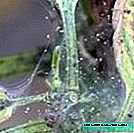
- Spider mite on pachistachis
Propagation of pachistachis by cuttings
Pachistachis at home propagated by cuttings. To obtain new plants, you can use the shoots left after spring pruning. Cuttings are rooted in two ways: by sprouting roots in water and planting in the ground. In the first case, planting material is lowered into a glass with a small amount of water, wait for the roots to appear and plant young plants in the ground. To stimulate root formation in water, you need to add a stimulant (a few drops of aloe juice, Kornevin, etc.). Unfortunately, when propagating by this method, a small percentage of plants survive, a large part decays during rooting. Using the second method, cuttings root in moist soil.
Root pachistachis in the soil:
We prepare small pots with a diameter of 12-15 cm.

Pots for planting pachistachis cuttings
We fill it with light soil, consisting of peat and sand (2: 1), slightly moisten the soil.

Pachistachis potted soil pot
We take cuttings 10-15 cm long, remove the lower leaves.

Pachistachis rooting cuttings
We lower the lower part of the shoot into the drug Kornevin (available in powder form).

Cuttings treated with Kornevin
We plant plants in the ground, deepening the lower part by 1-1.5 cm.

Pachistachis planted in the ground
We cover small pachistachis with a cap from a jar or a cut plastic bottle.

Pachistachis cuttings covered with a cap from a plastic bottle
The formation of the root system will take about a month. Caps can be removed when new leaves appear on the cuttings. A young plant will need to get used to the reduced humidity, so do not remove the protective containers immediately. Start from 1 hour per day and gradually increase the time so that after 2 weeks completely abandon the shelter.
Grow Reviews
Advantages: easy to care; unusual inflorescence; Disadvantages: frequent watering; Pachistachis has been living on my windowsill for about 2 years. I can’t say that I’m in love with him, but the guests always pay attention to him and he constantly pleases me with flowering. This amazing plant attracts attention with the originality of the inflorescence. The inflorescence resembles a spikelet and can be quite large. Caring for pachistachis is very simple and anyone can handle it. The plant grows very quickly, so it is recommended to transplant it every 2-3 years. But I just break off branches that are too high and that’s all and I always have a neat plant. Prefers bright diffused light. Loves moisture very much, therefore it needs to be watered and sprayed very often. If you forget to water, the leaves wither and fall and a bare trunk remains. I water my pachistachis in the summer every day and he thanks me with flowering.
Irishka-omsk//otzovik.com/review_428627.html
And I had a little one, I pinch off a friend, but bloomed for 3 months ... The neighbors did not believe that he was alive ... they came to see how beautiful and unusual he was ... 3 cones blossomed on it like candles, very beautiful: p !!!
Nika//forum.bestflowers.ru/t/paxistaxis-uxod-v-domashnix-uslovijax.1902/page-2
And I updated my spring - I rooted young cuttings. So on only one flower and bloomed. All summer, the lush bush grew. And I nibbled it a little and fertilized it, and sprayed the leaves, and put it on the ground under the scattered salt - no more flowers were waiting. And I really wanted to. One green tops stands. By the way, it’s not feathers, it’s such a flower. First, he grows a yellow head of cabbage, which gradually increases in size, and then such little white “feathers” appear on the sides. Then the little white one fades, and the yellow head of cabbage pleases the eye for a long time. Even when it falls off, it withers not once. One word - BEAUTY.
Lyudmila Nikolayevna//flo.com.ua/forum/viewtopic.php?t=8555
Video: Pachistachis cultivation
Pachistachis is an unusual tropical plant with original flowers that look like candles. Adhering to the simple rules of care, you can grow a beautiful and compact bush and achieve annual long flowering.












